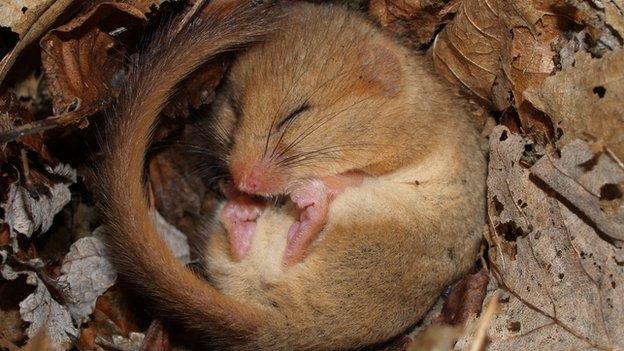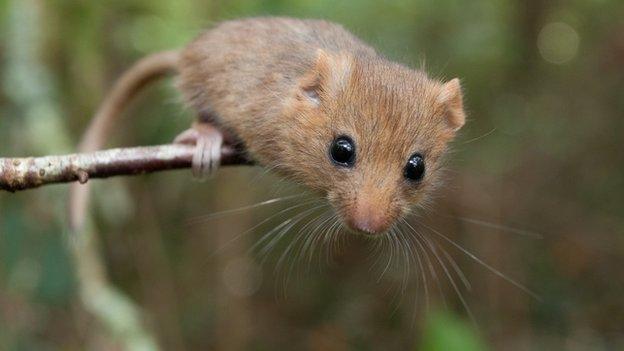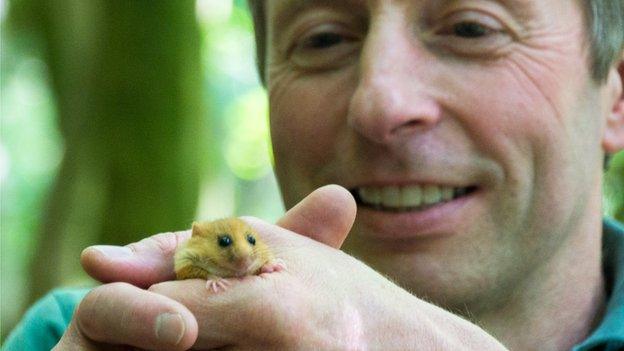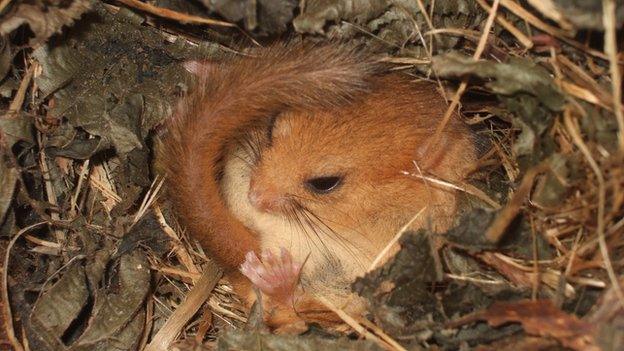Dormice in Britain 'vulnerable to extinction'
- Published

The researchers have been monitoring dormouse numbers since 1990
Britain's native dormouse has declined by more than a third since the year 2000 according to a new report by wildlife charity, the People's Trust for Endangered Species.
The State of Britain's Dormice report also shows that hazel dormice are extinct in 17 English counties.
The researchers assessed more than 100,000 records gathered from across the UK over 25 years.
The report says the dormouse is now vulnerable to extinction in Britain.
Since 1998 trained volunteers around the country have been gathering data on the tiny hazel dormouse (Muscardinus avellanarius). It is one of the longest-running small mammal monitoring projects in the world.
The creatures live mainly in hedgerows and woods, weaving ball-like nests in the undergrowth from bark in the summer and hibernating on or near the ground in winter between October and May.
They are extremely tricky to locate - a populated area the size of two football fields will only contain four dormice. A giveaway sign is a nibbled hazelnut.

Hazel dormice are 6-9cm long and weigh 17-20g - although this can double before hibernation.
'Dramatic decline'
Today's report shows that they are more difficult to find than ever. Over the last 16 years, the population has declined by almost 40%. Populations are now restricted to the Welsh borders and southern England. They have never been recorded in Scotland or Northern Ireland.
Ian White is dormouse officer at the People's Trust for Endangered Species. He has been monitoring the species for the last decade and describes the decline as "dramatic". He says: "Dormice have been around for 40 million years, but their future in Britain is now precarious and there's a pressing need for action to ensure their long-term survival."
In 1885, dormice were present in 49 English counties; today, they're known in 32 - excluding those counties where they have been reintroduced.
Mr White said the evidence pointed towards a few key factors in their decline. They are a woodland animal and there has been a loss of woodland and hedgerows. Their habitats are more fragmented and they can't disperse through the landscape.
The management of farmland and woodland has also changed making it harder for them to survive. They are also vulnerable to changes in the weather, in particular wetter springs and summers, when foraging for food becomes harder. Warmer winters also interrupt successful hibernation.

Dormouse officer Ian White helps to reintroduce a dormouse to the Yorkshire Dales.
Mr White said: "This is a sad tale, the raw data is a bit doom and gloom but my personal experience is that there is a lot more interest in what we can do about this and a lot of enthusiasm from the public to help."
There have been efforts to bring hazel dormice back to the wild. More than 850 animals have been reintroduced at 26 sites. The latest was at Aysgarth in Wensleydale in June. At five of these release sites the population has died. The others have shown signs of success, such as breeding or dispersal to new areas beyond the site.
PTES monitors 400 sites regularly along with building a national dataset from the information that the public sends in. They also help to train woodland managers and landowners.

If the weather is cold and wet and there isn't much food, dormice curl in to a ball and sleep.
Follow Claire on Twitter, external